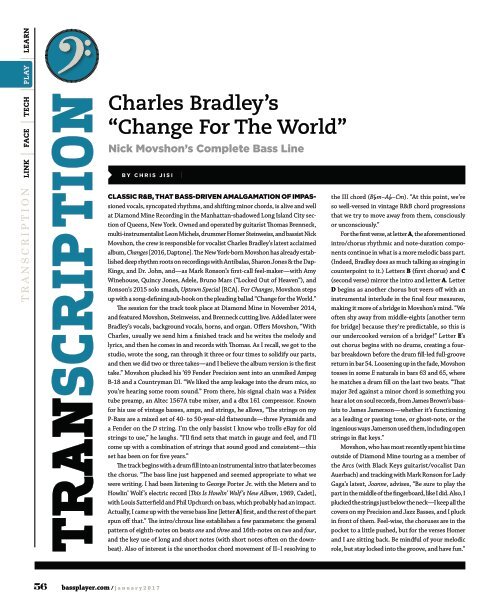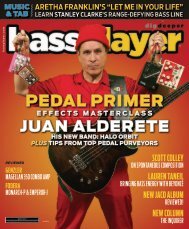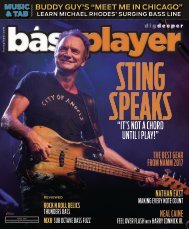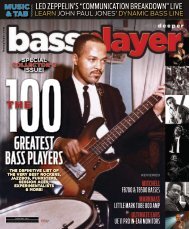BassPlayer 2017-01
BassPlayer 2017-01
BassPlayer 2017-01
You also want an ePaper? Increase the reach of your titles
YUMPU automatically turns print PDFs into web optimized ePapers that Google loves.
TRANSCRIPTION LINK FACE TECH PLAY LEARN<br />
?<br />
TRANSCRIPTION<br />
Charles Bradley’s<br />
“Change For The World”<br />
Nick Movshon’s Complete Bass Line<br />
By CHRIS JISI |<br />
ClaSSIC R&B, that baSS-driven amalgamation of impassioned<br />
vocals, syncopated rhythms, and shifting minor chords, is alive and well<br />
at Diamond Mine Recording in the Manhattan-shadowed Long Island City section<br />
of Queens, New York. Owned and operated by guitarist Thomas Brenneck,<br />
multi-instrumentalist Leon Michels, drummer Homer Steinweiss, and bassist Nick<br />
Movshon, the crew is responsible for vocalist Charles Bradley’s latest acclaimed<br />
album, Changes [2<strong>01</strong>6, Daptone]. The New York-born Movshon has already established<br />
deep rhythm roots on recordings with Antibalas, Sharon Jones & the Dap-<br />
Kings, and Dr. John, and—as Mark Ronson’s first-call feel-maker—with Amy<br />
Winehouse, Quincy Jones, Adele, Bruno Mars (“Locked Out of Heaven”), and<br />
Ronson’s 2<strong>01</strong>5 solo smash, Uptown Special [RCA]. For Changes, Movshon steps<br />
up with a song-defining sub-hook on the pleading ballad “Change for the World.”<br />
The session for the track took place at Diamond Mine in November 2<strong>01</strong>4,<br />
and featured Movshon, Steinweiss, and Brenneck cutting live. Added later were<br />
Bradley’s vocals, background vocals, horns, and organ. Offers Movshon, “With<br />
Charles, usually we send him a finished track and he writes the melody and<br />
lyrics, and then he comes in and records with Thomas. As I recall, we got to the<br />
studio, wrote the song, ran through it three or four times to solidify our parts,<br />
and then we did two or three takes—and I believe the album version is the first<br />
take.” Movshon plucked his ’69 Fender Precision sent into an unmiked Ampeg<br />
B-18 and a Countryman DI. “We liked the amp leakage into the drum mics, so<br />
you’re hearing some room sound.” From there, his signal chain was a Psidex<br />
tube preamp, an Altec 1567A tube mixer, and a dbx 161 compressor. Known<br />
for his use of vintage basses, amps, and strings, he allows, “The strings on my<br />
P-Bass are a mixed set of 40- to 50-year-old flatwounds—three Pyramids and<br />
a Fender on the D string. I’m the only bassist I know who trolls eBay for old<br />
strings to use,” he laughs. “I’ll find sets that match in gauge and feel, and I’ll<br />
come up with a combination of strings that sound good and consistent—this<br />
set has been on for five years.”<br />
The track begins with a drum fill into an instrumental intro that later becomes<br />
the chorus. “The bass line just happened and seemed appropriate to what we<br />
were writing. I had been listening to George Porter Jr. with the Meters and to<br />
Howlin’ Wolf’s electric record [This Is Howlin’ Wolf ’s New Album, 1969, Cadet],<br />
with Louis Satterfield and Phil Upchurch on bass, which probably had an impact.<br />
Actually, I came up with the verse bass line [letter A] first, and the rest of the part<br />
spun off that.” The intro/chrous line establishes a few parameters: the general<br />
pattern of eighth-notes on beats one and three and 16th-notes on two and four,<br />
and the key use of long and short notes (with short notes often on the downbeat).<br />
Also of interest is the unorthodox chord movement of II–I resolving to<br />
the III chord (Bbm–Ab–Cm). “At this point, we’re<br />
so well-versed in vintage R&B chord progressions<br />
that we try to move away from them, consciously<br />
or unconsciously.”<br />
For the first verse, at letter A, the aforementioned<br />
intro/chorus rhythmic and note-duration components<br />
continue in what is a more melodic bass part.<br />
(Indeed, Bradley does as much talking as singing in<br />
counterpoint to it.) Letters B (first chorus) and C<br />
(second verse) mirror the intro and letter A. Letter<br />
D begins as another chorus but veers off with an<br />
instrumental interlude in the final four measures,<br />
making it more of a bridge in Movshon’s mind. “We<br />
often shy away from middle-eights [another term<br />
for bridge] because they’re predictable, so this is<br />
our undercooked version of a bridge!” Letter E’s<br />
out chorus begins with no drums, creating a fourbar<br />
breakdown before the drum fill-led full-groove<br />
return in bar 54. Loosening up in the fade, Movshon<br />
tosses in some E naturals in bars 63 and 65, where<br />
he matches a drum fill on the last two beats. “That<br />
major 3rd against a minor chord is something you<br />
hear a lot on soul records, from James Brown’s bassists<br />
to James Jamerson—whether it’s functioning<br />
as a leading or passing tone, or ghost-note, or the<br />
ingenious ways Jamerson used them, including open<br />
strings in flat keys.”<br />
Movshon, who has most recently spent his time<br />
outside of Diamond Mine touring as a member of<br />
the Arcs (with Black Keys guitarist/vocalist Dan<br />
Auerbach) and tracking with Mark Ronson for Lady<br />
Gaga’s latest, Joanne, advises, “Be sure to play the<br />
part in the middle of the fingerboard, like I did. Also, I<br />
plucked the strings just below the neck—I keep all the<br />
covers on my Precision and Jazz Basses, and I pluck<br />
in front of them. Feel-wise, the choruses are in the<br />
pocket to a little pushed, but for the verses Homer<br />
and I are sitting back. Be mindful of your melodic<br />
role, but stay locked into the groove, and have fun.”<br />
56 bassplayer.com / january<strong>2<strong>01</strong>7</strong>






